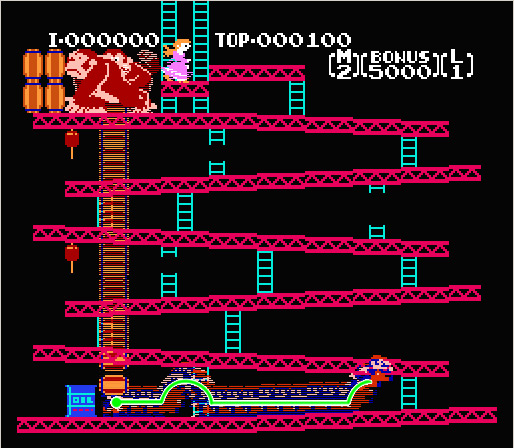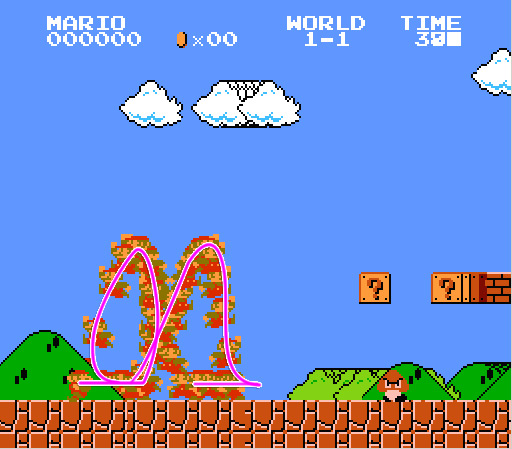 |
| Jump button from a Donkey Kong (Nintendo 1981) arcade game cabinet |
Jumping is such a quotidian action in digital games that it seems like its been a part of gaming from the start. However, it wasn't until 1981 when Nintendo released Donkey Kong in the arcades, the first game to feature jumping (and the jump button pictured above). Sega's Jump Bug (1981) was released a few months later, the first game to feature both jumping and a smooth-scrolling screen frame. Jumping became the defining action of the platfomer genre, even though that genre predates jumping (platformers saw their debut back in 1980 with arcade titles Space Panic and Crazy Climber).


Jumping in Donkey Kong vs. jumping in Super Mario Bros. (images by Steve Swink, 2007. source: https://www.gamedeveloper.com/design/game-feel-the-secret-ingredient)
Mario's first Donkey Kong jump (and that of Donkey Kong Jr. (1982)) is very simple, mechanically speaking. Mario will always jump the same distance and to the same height every time, no matter how long the jump button is held down or how hard it is pressed. It follows a "specific, predetermined arc" (Swink, Game Feel (2009) pg. 201). Once jumping in a particular direction, there is no way to move the joystick in opposite direction to cancel the jump. This is what I refer to as a static jump, what Joshua Bycer calls a "commited jump" in his book, Game Design Deep Dive: Platformers. Additionally, Mario always runs at the same speed and stopes instantly, with no acceleration or deceleration. Similar static jumps are featured in jumping games that followed, like Irem's arcade hit Moon Patrol (1982) and Activision's Pitfall (1982) for the Atari VCS and Namco's Pac-Land (1984).
The static jump began as a purely defensive or navigational action to avoid threats, clear obstacles. or leap to a higher platform. Touching an enemy character typically meant instant death, so there was no concept for jumping onto enemies to defeat them.
By the time Shigeru Miyamoto and his team worked on Mario Bros. (1983), they started experimenting with Mario's (and brother Luigi's) movement. Gunpei Yokoi convinced Miyamoto that Mario should be able to jump with superhuman strength and fall great distances without fear of injury. Donkey Kong's short jumps and deadly falls feel cruel and punishing in comparison to Mario Bros.' tremendous leaps. Mario and Luigi also accelerate quickly from stopped to walking speed to running speed as they move horizontally (Swink 2009, pg. 202). Mario and Luigi also made a little slide as they decelerated to change directions. These jumps were still static, but the player characters were more controllable in their movement.
Nintendo's Super Mario Bros. (1985) offered an unprecedented level of control to the player during jumps with what I dub a dynamic jump. The longer the jump button is held down, the higher the character jumps. Depressing the "run" button lets the player accelerate their character from a walking speed to a fast running speed (walking max. speed is about 3/5 of running max. speed). The player is also able to accelerate horizontally, or "steer" their character in mid-air, during a jump. This opens up player control and gives the game a "highly fluid motion" (Swink 2007).
Note: Steve Swink's Game Feel (2009) is a book that I've referenced before and will likely return to many times. It still stands as the default text on the subject, but hope that Swink gets the opportunity to create a 2nd edition for the book (something he's been hoping to do in order to update some information "where the thinking has evolved" (2010)). I bought the book new back in 2009 while I was working on fine-tuning controls for a console FPS game and thought it was a great leap forward in thinking and creating a language to think, plan, and talk about my design. His works define games around three principles of real-time control, spatial simulation, and polish. However, his work is different in examining the static/dynamic jump I analyze above.
The dynamic jump did not immediately change the world of platformers; many games created soon after SMB still featured the static jump (and some still do to this day). I see this additional control in jumping as a major evolution in the platformer genre, adding expressiveness and agency to the game action. Some of the most influential platformer series of the 1980s feature their own variations on the dynamic jump, like Mega Man/Rockman (full horizontal control during jump) and Sonic the Hedgehog (momentum-based movement, "vertical jumps" at same angle of slope character is standing on).
Continued in Part 2...




No comments:
Post a Comment